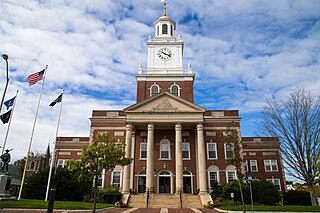
Dover is a city in Strafford County, New Hampshire, United States. The population was 32,741 at the 2020 census, making it the largest city in the New Hampshire Seacoast region and the fifth largest municipality in the state. It is the county seat of Strafford County, and home to Wentworth-Douglass Hospital, the Woodman Institute Museum, and the Children's Museum of New Hampshire.

Rollinsford is a town in Strafford County, New Hampshire, United States. The population was 2,597 at the 2020 census. The main village in town was once known as "Salmon Falls Village".
A mill town, also known as factory town or mill village, is typically a settlement that developed around one or more mills or factories, usually cotton mills or factories producing textiles.

The Cochecho River is a tributary of the Piscataqua River, 38.3 miles (61.6 km) long, in the U.S. state of New Hampshire. It rises in northern Strafford County and runs southeastward, through the town of Farmington and the cities of Rochester and Dover, where it provides hydroelectric power. Below the center of Dover, the river is tidal and joins the Salmon Falls River at the Maine border to form the Piscataqua. Significant tributaries include the Ela River, the Mad River, and the Isinglass River.

The Hayward Mill is a historic mill complex at the junction of North and Cook Streets, on the Mumford River in Douglas, Massachusetts. The site, with an industrial history dating to the 18th century, is populated by a series of connected buildings dating to 1880 or later. The mill was the first financial successful textile operation in Douglas, and was operated until the 1960s. The mill complex was listed on the National Register of Historic Places in 1991. It has been converted to residential use.

The Metacomet Mill, built in 1847 by Colonel Richard Borden for the manufacture of cotton textiles, is the oldest remaining textile mill in Fall River, Massachusetts.

The North Canal Historic District of Lawrence, Massachusetts, encompasses the historic industrial heart of the city. It is centered on the North Canal and the Great Stone Dam, which provided the waterpower for its many mill complexes. The canal was listed on the National Register of Historic Places in 1975, while the district was first listed in 1984, and then expanded slightly in 2009.

The Union Mill Complex,, is located at the junction of Milton Avenue and Prospect Street in Ballston Spa, New York, United States. It is a complex of three late 19th-century brick buildings on a 4-acre lot, and the ruins of a dam.
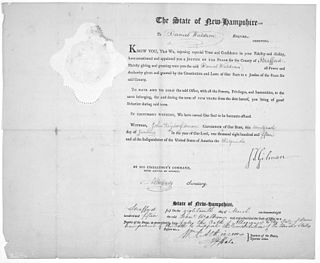
Daniel Waldron was an American merchant and mill owner. He was the fifth and last generation of his family to hold the substantial Waldron estate in Dover, New Hampshire. With his bankruptcy, Dover realized a new life and economy as a center of textile manufacturing.
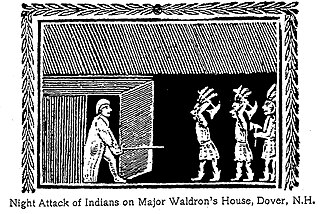
The Raid on Dover happened in Dover, New Hampshire on June 27–28, 1689. Led by Chief Kancamagus, it began King William's War, a series of Indian massacres orchestrated by Jean-Vincent d'Abbadie de Saint-Castin and Father Louis-Pierre Thury.

The Winooski Falls Mill District is located along the Winooski River in the cities of Winooski and Burlington, Vermont, in the United States of America. It encompasses a major industrial area that developed around two sets of falls on the river in the 19th century.

The Nashua Manufacturing Company Historic District in Nashua, New Hampshire, is a historic district that was listed on the National Register of Historic Places (NRHP) in 1987. It encompasses an area just west of downtown Nashua, roughly located along the southern bank of the Nashua River, bordered on the west side by Mine Falls Park, on the south side by the Nashua River canal, up to Ledge Street, and from the east side by Factory, Pine and Water streets, up to the Main Street bridge.

The Manomet Mills are a historic textile mill complex on the north side of New Bedford, Massachusetts. They are located between Riverside Avenue and the Acushnet River, north of Manoment Street and the Whitman Mills. The complex consists of three Classical Revival brick buildings, built between 1903 and 1907. The main building, Mill No. 1, is a 54-bay three story structure that was built in 1903. It is attached to Mill No. 2 (1907), of similar size, by a single story brick structure. The third building is the Mill No. 2 Department Room (1907), a two-story brick building that was originally connected to the other two via overhead bridges, now removed. The mill complex was the main operating site of the Manoment Mill Company, which produced cotton yarn until about 1928. The buildings were sold in that year to the Delaware Rayon Company, which went bankrupt in 1954. Mill No. 2 was then used by the Acushnet Process Company for the manufacture of golf balls, while Mill No. 1 continued to be used for rayon production, a chemically intensive and environmentally hazardous process.

The Jaffrey Mills is a historic mill complex at 41 Main Street, in the central business district of Jaffrey, New Hampshire. It consists of a connected series of primarily brick buildings flanking the Contoocook River just north of Main Street. Its oldest buildings, the original mill and office building, are on the west side of the river. They were built in 1868, and feature mansard roofs and banded dentil brick cornices. The mill building has a tower that originally sported a cupola, but this was removed early in the 20th century. In 1872 the building on the east side was built, and the two sides joined by timber-frame bridges were added in 1897, at the same time the east building was extended northward. Later additions to the north of the east building include a storage area and a loading dock. The mill complex, the only 19th-century industrial complex of its type to be built in Jaffrey, was listed on the National Register of Historic Places in 1982. It has been converted into residences.

The Hillsborough Mills are a historic textile manufacturing complex at 37 Wilton Road in western Milford, New Hampshire, near its town line with Wilton. The oldest buildings of the brick mill complex were built in 1866 as a carpet-making operation. This business failed in 1874, but the complex was acquired by other textile interests, and eventual saw success producing carpet yarns, and blankets for horses and bedding. The mills were closed in 1970, and have since been adapted for other uses. The complex was listed on the National Register of Historic Places in 2014.
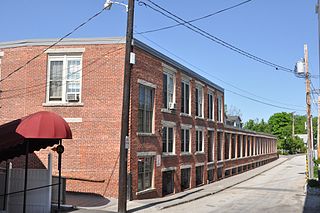
The Milford Cotton and Woolen Manufacturing Company is a historic mill complex at 2 Bridge Street in the center of Milford, New Hampshire. Developed between 1813 and World War I, it is one of the few surviving mill complexes in Milford, whose name is derived in part from "mill". The buildings were listed on the National Register of Historic Places in 1982. The complex has been converted into residential use.

The Woodbury Mill is a historic mill building at 1 Dover Street in Dover, New Hampshire. This five-story utilitarian brick mill building was built in 1885 by the Dover Improvement Association as a factory space for small footwear manufacturers to operate in, representing an organized effort by city businessmen to attract this type of business. It was used for shoe manufacturing until 1979, and was listed on the National Register of Historic Places in 2013.

The Sawyer Woolen Mills is a historic textile mill complex at 1 Mill Street in Dover, New Hampshire. Built in stages between 1873 and 1939, the mill complex is one of New Hampshire's most intact mill complexes, reflecting multiple architectural styles which were retained by addition to the complex rather than by the demolition of older buildings. The mills were listed on the National Register of Historic Places in 1989.

The Sawyer Building is a historic commercial building at 4-6 Portland Street in Dover, New Hampshire. The three-story brick structure was built in 1825, during Dover's period of economic prosperity following the establishment of its textile mills. It is one of Dover's oldest commercial buildings. The building was listed on the National Register of Historic Places in 1980.
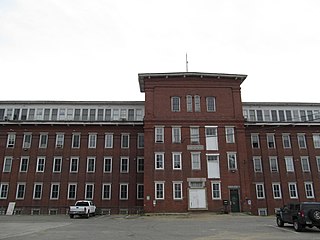
The Salmon Falls Mill Historic District encompasses a historic mill complex on Front Street in Rollinsford, New Hampshire. The complex includes four major structures and seven smaller ones, on about 14 acres (5.7 ha) of land along the Salmon Falls River. They were built between about 1840 and the mid-1860s, and have an unusual architectural unity, for additions made to the buildings were done with attention to matching design elements from the existing structures. The Number 2 Mill, built in 1848, was an early location where a turbine was used instead of a waterwheel to provide power to the mill machinery. The district was listed on the National Register of Historic Places in 1980.























